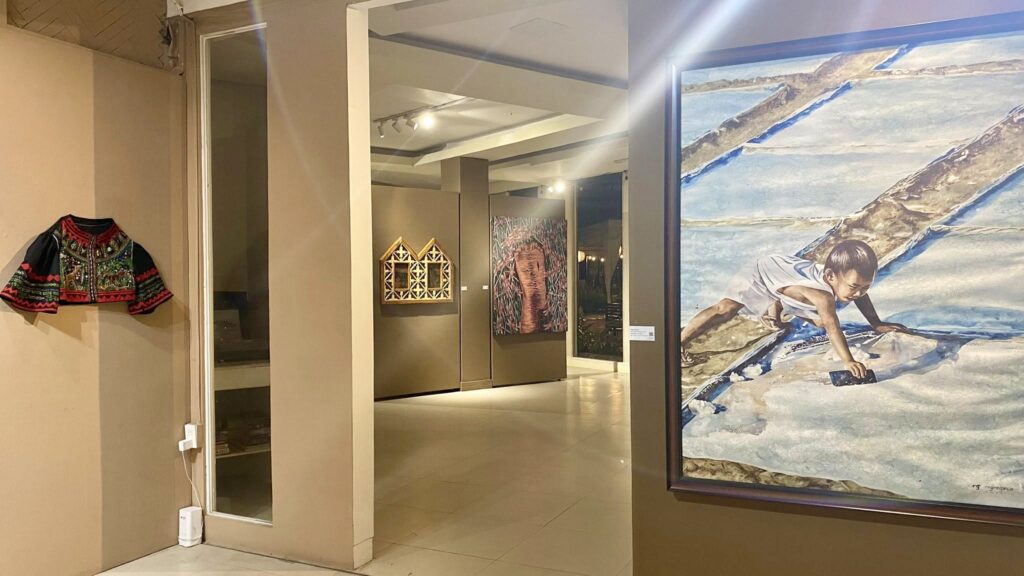How would a visual medium encapsulate abstract understandings of location, dimension, space, setting, and the miscellany of social themes and issues which come to play in the liminalities and peripheries between and among them?
Thrive Art Gallery’s current exhibit attempts to provide an answer. Featuring the artworks of Ivy Marie Apa, Margaux Blas, JM Blor, Kristoffer Brasileño, Lorebert Comision, Peter James Fantinalgo, Regine Garcia, and Arel Zambarrano, Everywhere is Here is a compression of these familiar spaces, as interpreted through archetypes which capture the mundane and the symbolic. Less of an existential discernment of dimension than an aesthetic projection of what transpires through dimensions, the exhibit attempts to disrupt the viewer’s understanding of the fabric of space by simultaneously presenting the occasions and incidence of Everyday: in the canvases and assemblages, Where-ness and Here-ness are transfixed by the ever-Present iconography of the artist.
Two discernible motifs surface in the exhibit: the ubiquity of patterns in the artworks and the metaphors of home and household, as framed through both traditional and contemporary perspectives and representations. Both challenge the conventional liminality of familiar spaces. Online curatorial notes describe how the exhibit “aims to ask how artists confront issues of power, representation, and inclusion in the construction of collective memory” even as past and present, the local and the global, the personal and public are reinterpreted and reshaped through spaces and distances blurred by a globalization inundated by digital networks.

As if to look back to how it is recognized as an elemental principle of art which nature primarily provides, patterns in the artworks underline this sense of universality and rhythmic mundaneness, permeating the art with a semblance of accustomed routine yet also of fresh spontaneity. Typical of his style, Arel Zambarrano’s canvases are replete with iterations of steel-gray nails and crimson dragonflies surrounding his subjects. Peter James Fantinalgo’s assemblages of wood are reminiscent of the birha, the traditional decorative bamboo lattice-work which encases window frames of the bahay kubo – now elevated as decorative borders emphasizing his art’s subjects. Regine Garcia’s Narratives – a series of large canvases capturing scenes and vignettes of local life and color – employ the subtleties of patterned designs, whether in layered characterizations, geometric perspective as backgrounds, or repeated figures inundating the entire canvas.
This ubiquity of patterns frames and contrasts images associated with home life and domestic contexts. Margaux Blas’ Zero Waste Life puts together a pastiche of odds and ends found in obscure drawers or dusty basements, achieving a macabre portrait of sorts framed by the mundaneness of the daily grind of life. Kristoffer Brasileño’s Domicility offers a pensively lethargic self-portrait of the artist asleep over what appears to be a desk crowded with Daliesque deliberation, beneath which overflows the ephemera of life: a katana, an alarm clock, a row of bottles, a laden clothesline, a hand of bananas, and an assortment of statuettes depicting the sacred and the profane. Contrasting the overwhelming material and surreal imagery in Brasileño’s work, JM Blor’s Spores to Spine – an embroidered saypang, the traditional scarlet blouse of the Panay Bukidnon – brims with flora and fauna endemic to the island, reminiscent of an older time perhaps when our ways and manners are more attuned with the rhythms and rimes of nature.
While it showcases the quotidian, the exhibit also attempts to break through the conventionalities corseted within the home and explores external factors and aspects, which in one way or another, exert their influence in our perceptions of homelife. In Ivy Marie Apa’s Flayed series, human appendages from Jusepe de Ribera’s classical portraits are juxtaposed on brown paper bags patterned with familiar golden arches, a comment perhaps on pop food culture where sustenance is commodified and a product’s (or a person’s?) marketing is consumed as much as the actual food: more delectable than the burger is the brand. Lorebert Comision’s Portodisbidyu provides a complementary montage exploring metaphors emblematic of the politicization of institutions through the commodification of the self, an unsavory combination that makes itself felt every three or six years, to bleak (and bleaker!) results.
Regine Garcia’s series of Narratives projects a homely chronicle most recognizable to our consciousness, one of origins, transference, and resilience. Three framed watercolors interpret these chapters through the portrayal of the laboring class. In Origins, the crouching figure of a young boy scraping salt is set amid the sprawling geometry of salt-beds shimmering white with marsh-brine residue. In Transference, the spread of tabagak (dried local herring) splayed across a bamboo drying frame is interjected by gnarly hands which seem to apologetically disrupt the rhythm of the piscine rows, as they distribute the pieces across the board. Evocative of the labors of farm and field, the tiers of characters set against a bright lemon-yellow background become the subjects of Resilience: portrayed with the burden of farm implements and of harvest and catch, the figures suggest a hierarchy of equals trapped in an incessant loop of hard work and survival.
In a manner of speaking, space and distance are condensed – or redefined, at least – within the gallery. What eclectic snaps and snippets can be encountered by the viewer are simulacra of larger and more expansive social narratives, as lived or observed by the artists. We might argue about the qualities and attributes of Where-ness and Here-ness – and the blurred liminalities in between – yet there is an attempt to enflesh the idea into image. Titling the exhibit with the suggestion that Everywhere is Here might be a simplified exaggeration, but the artworks suggest sharp and possibly repressed introspections and questions about the mundanity of our existence, here and always; uncomfortable perhaps, but nonetheless significant and weighty.